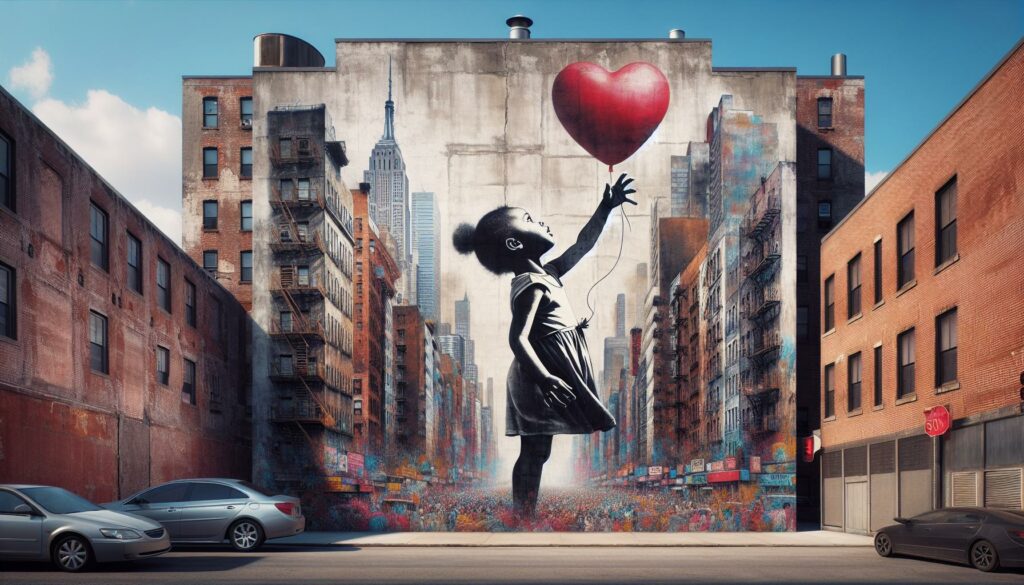Banksy, the enigmatic street artist, has captivated the world with his provocative and thought-provoking works. I’ve always been fascinated by the way he manages to blend social commentary with stunning visual art, often appearing overnight in unexpected locations.
As an anonymous figure, Banksy’s identity remains a mystery, adding to the intrigue surrounding his art. His pieces tackle pressing issues like war, consumerism, and political corruption, forcing viewers to confront uncomfortable truths about society. From stenciled rats to subversive installations, Banksy’s art continues to challenge our perceptions and spark conversations across the globe.
Key Takeaways
- Banksy is an anonymous street artist known for provocative works addressing social and political issues
- His signature style includes stencil techniques, dark humor, and unexpected urban locations
- Banksy’s art challenges traditional institutions and has inspired a new generation of street artists
- Notable works like “Girl with Balloon” and “Love Is in the Bin” have sold for millions at auctions
- Despite commercial success, Banksy continues to create thought-provoking installations and critique societal norms
artist:wwvgid0bvkk= banksy
Banksy is an enigmatic street artist whose true identity remains unknown. Despite his global fame, the artist has successfully maintained anonymity while creating thought-provoking works that challenge societal norms.
The Mystery Behind the Artist
Banksy’s identity is one of the art world’s best-kept secrets. Speculation about the artist’s background ranges from theories of a single individual to a collective of artists working under one pseudonym. While various names have been proposed, including Robin Gunningham and Robert Del Naja, Banksy’s true identity remains unconfirmed. This anonymity adds to the intrigue surrounding the artist’s work and allows the focus to remain on the art itself rather than the creator.
Banksy’s Signature Style
Banksy’s art is instantly recognizable, characterized by:
- Stencil technique: Precise, detailed images created using stencils and spray paint
- Dark humor: Witty, often satirical messages conveyed through visual puns
- Social commentary: Addressing issues like war, capitalism, and environmental concerns
- Unexpected locations: Appearing on urban walls, bridges, and even inside museums
The artist’s style combines elements of graffiti, pop art, and political activism. Banksy’s works often feature recurring motifs such as rats, monkeys, and children, used to convey complex ideas in simple, striking images. This unique approach has made Banksy’s art accessible to a wide audience while maintaining its subversive edge.
The Rise of Banksy’s Street Art

Banksy’s ascent in the street art world began in the 1990s, transforming urban landscapes into canvases for social commentary. His provocative and thought-provoking pieces quickly gained attention, catapulting him from a local Bristol artist to a global phenomenon.
Early Works and Influences
Banksy’s artistic journey started in Bristol’s underground scene, where he honed his stencil technique. Inspired by 3D, a member of the musical group Massive Attack, Banksy developed his signature style that blended graffiti with political and social messages. His early works featured freehand graffiti and stenciled rats, symbols of urban decay and resilience. These pieces, often found on Bristol’s streets, laid the foundation for his future fame.
Notable Pieces and Locations
Banksy’s art has graced walls worldwide, from London to New York and beyond. Some of his most iconic works include:
- “Girl with Balloon” (London, 2002): A simple yet powerful image of a girl reaching for a heart-shaped balloon.
- “Kissing Coppers” (Brighton, 2004): A provocative depiction of two policemen kissing.
- “Napalm Girl” (London, 2004-2005): A reimagining of the famous Vietnam War photograph with Mickey Mouse and Ronald McDonald.
- “The Flower Thrower” (Jerusalem, 2003): A masked protester throwing a bouquet instead of a Molotov cocktail.
- “Mobile Lovers” (Bristol, 2014): Two lovers embracing while checking their phones, commenting on modern relationships.
These pieces, strategically placed in high-profile locations, garnered significant media attention and public discourse. Banksy’s ability to choose impactful sites for his art, from the West Bank barrier to Disneyland, amplified his messages and cemented his reputation as a provocative and influential artist.
Banksy’s Social and Political Commentary

Banksy’s art serves as a powerful medium for social and political commentary, challenging societal norms and provoking thought on critical issues. His works offer biting critiques of contemporary society, addressing themes ranging from consumerism to war.
Critiquing Consumerism and Capitalism
Banksy’s art frequently targets the excesses of consumer culture and capitalism. His piece “Show Me the Monet” reimagines Claude Monet’s famous water lily painting, adding abandoned shopping carts and traffic cones to the serene scene. This juxtaposition highlights the impact of consumerism on nature and beauty. Another notable work, “Sale Ends,” depicts a group of women in Victorian dress rushing towards a sign reading “Sale Ends Today,” satirizing the frenzied nature of consumer behavior.
Addressing War and Conflict
Banksy’s commentary on war and conflict is equally poignant. His mural “Love is in the Air” shows a protestor throwing a bouquet of flowers instead of a Molotov cocktail, symbolizing the power of peaceful resistance. In “CND Soldiers,” Banksy depicts two soldiers painting a peace sign, questioning the role of military forces in maintaining peace. These works challenge viewers to reconsider their perspectives on conflict resolution and the human cost of war.
Banksy’s Impact on the Art World

Banksy’s influence on the art world extends far beyond his provocative street art. His work has reshaped perceptions of what art can be and where it can exist, challenging traditional norms and inspiring new generations of artists.
Challenging Traditional Art Institutions
Banksy’s approach to art has fundamentally challenged established art institutions. He’s bypassed galleries and museums, bringing art directly to the public through unauthorized installations in urban spaces. This strategy has forced the art world to reconsider the value and legitimacy of street art. In 2018, Banksy’s “Girl with Balloon” self-destructed moments after being sold at Sotheby’s for $1.4 million, critiquing the commercialization of art. This act, later renamed “Love is in the Bin,” became the first artwork created live at auction, further blurring the lines between performance and visual art.
Inspiring a New Generation of Street Artists
Banksy’s success has paved the way for street art to gain mainstream recognition, inspiring countless artists worldwide. His techniques, particularly stenciling, have been widely adopted by emerging street artists. The anonymity Banksy maintains has also influenced others to create under pseudonyms, focusing attention on the art rather than the artist. Street art festivals, such as Upfest in Bristol, now attract thousands of artists and spectators annually, showcasing the growing popularity of this art form. Banksy’s work has also inspired the creation of street art tours in cities like London, Berlin, and New York, further legitimizing and promoting this form of artistic expression.
Banksy’s Most Famous Works
Banksy’s portfolio boasts numerous iconic pieces that have captivated audiences worldwide. These works showcase his signature style, blending social commentary with striking visual elements.
Girl with Balloon
“Girl with Balloon” ranks as one of Banksy’s most recognizable and beloved works. Created in 2002, this stencil mural depicts a young girl reaching towards a red heart-shaped balloon. The image’s simplicity and poignancy resonate with viewers, symbolizing hope, innocence, and the fleeting nature of childhood. Originally appearing on London’s South Bank, reproductions of this piece have since emerged in various locations and formats, including prints and canvas versions.
Love Is in the Bin
“Love Is in the Bin” evolved from “Girl with Balloon” in a dramatic auction event. In October 2018, a framed “Girl with Balloon” print sold at Sotheby’s for £1.04 million. Moments after the sale, the artwork began to shred itself through a hidden mechanism in the frame. The partially shredded piece, renamed “Love Is in the Bin,” became an instant sensation. This audacious act transformed the original work into a new piece of performance art, challenging notions of value and authenticity in the art world. The altered artwork later resold for £18.5 million in 2021, further cementing its status as a pivotal moment in contemporary art history.
The Commercialization of Banksy’s Art
Banksy’s art has become a hot commodity in the art market, with his works fetching astronomical prices at auctions. This commercialization stands in stark contrast to the artist’s anti-establishment ethos and critiques of capitalism.
Auction Sales and Record-Breaking Prices
Banksy’s pieces have consistently shattered auction records, with collectors willing to pay millions for his work. In 2018, “Girl with Balloon” sold for £1.04 million at Sotheby’s, only to partially self-destruct moments later. The resulting piece, renamed “Love is in the Bin,” later resold for £18.5 million in 2021. Other notable sales include “Devolved Parliament,” which fetched £9.9 million in 2019, and “Game Changer,” which sold for £16.8 million in 2021, with proceeds benefiting UK health charities. These record-breaking prices highlight the irony of Banksy’s anti-capitalist messages becoming highly valuable commodities.
Banksy’s Response to Commercialization
Banksy has frequently expressed disdain for the commercialization of his art. In 2013, he set up a pop-up stall in New York’s Central Park, selling original canvases for $60 each, with only a few people purchasing them. The “Girl with Balloon” shredding incident at Sotheby’s auction house in 2018 was a direct critique of the art market’s obsession with monetary value. Banksy’s creation of “Gross Domestic Product,” an online store selling “impractical and offensive” merchandise, further mocked the commercialization of his brand. Despite these efforts, the demand for Banksy’s work continues to grow, creating a paradoxical relationship between his anti-establishment message and his commercial success.
Banksy’s Ongoing Legacy
Banksy’s influence continues to shape the art world and popular culture. His recent projects and installations demonstrate his ongoing commitment to social commentary and artistic innovation, while his impact on popular culture remains profound and far-reaching.
Recent Projects and Installations
Banksy’s recent works maintain his signature style of provocative social commentary. In 2020, he created “Game Changer,” a painting honoring healthcare workers during the COVID-19 pandemic. The piece, depicting a child playing with a nurse superhero doll, sold for £16.8 million, with proceeds benefiting UK health charities. In 2021, Banksy’s “A Great British Spraycation” series appeared across East Anglian coastal towns, featuring works that addressed climate change and gentrification. His 2022 installation in Ukraine, including a gymnast balancing on rubble in Borodyanka, highlighted the ongoing conflict and its impact on civilians.
Continued Influence on Popular Culture
Banksy’s impact on popular culture remains significant. His work continues to inspire street artists worldwide, influencing urban art movements and public space interventions. Banksy’s themes and techniques are frequently referenced in music, film, and fashion, with his imagery appearing on everything from album covers to clothing lines. Social media platforms have amplified his reach, with millions of followers eagerly anticipating and sharing his latest works. Banksy’s ability to spark conversations about social issues through art has inspired activists and artists alike, cementing his role as a cultural icon and a voice for social change.
unparalleled influence
Banksy’s impact on the art world and society is undeniable. Through his provocative works he’s challenged our perceptions sparked important conversations and redefined street art. His anonymity only adds to the intrigue surrounding his pieces which continue to captivate audiences worldwide. As Banksy’s influence grows his ability to blend art with social commentary remains unparalleled. He’s not just an artist but a cultural phenomenon shaping how we view and interact with art in public spaces. Banksy’s legacy will undoubtedly endure inspiring future generations of artists and thinkers to push boundaries and question the status quo.

